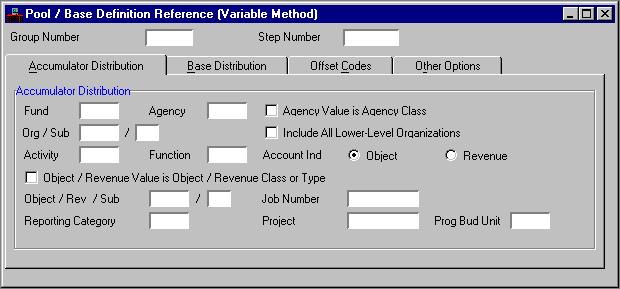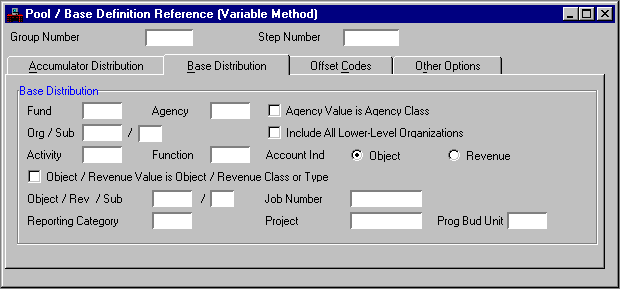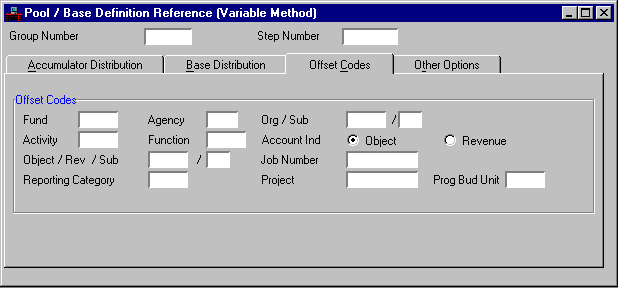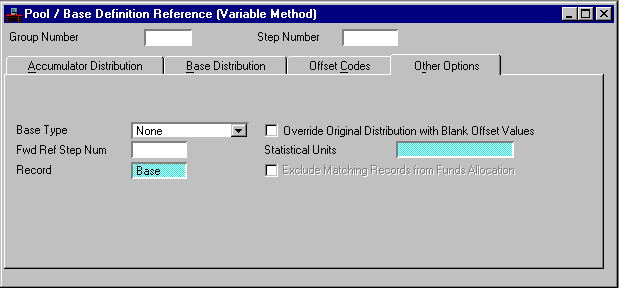|
|
|
Accumulator Distribution
|
|
Fund, Agency, Org/Sub, Activity, Function
|
Key field. Enter the accounting distribution used on the Cost Allocation General Ledger Inquiry (CAGL). Enter an asterisk [
*
] for a wild card entry or spaces to default this field.
|
|
Agency Value is Agency Class
|
Key field. Select to indicate that costs should be accumulated for all agencies belonging to the agency class.
|
|
Include All Lower-Level Organizations
|
Key field. Select to indicate that costs should be accumulated for all organizations under the specified organization in the organization hierarchy.
|
|
Account Ind
|
Key field. Select
Object [O]
if the value entered in
Object/Revenue/Sub
is an object; otherwise, select
Revenue [R]
.
|
|
Object/Revenue Value is Object/Revenue Class or Type
|
Key field. Default is cleared [
N
]. Select [
Y
] to indicate that the
Object/Revenue/Sub
field value is defined by an object class or type or revenue class or type.
|
|
Object/Rev/Sub
|
Key field. In the first field, enter an object or revenue source based on the
Account Indicator
. If
Object/Revenue Value is Object/Revenue Class or Type
is selected [
Y
], enter an object class or type or a revenue class or type. Enter an asterisk [
*
] for a wild card entry or spaces to default this field.
In the second field, enter a sub-object or sub-revenue source, if appropriate. Enter an asterisk [
*
] for a wild card entry or spaces to default this field.
|
|
Job Number, Reporting Category, Project, Program Budget Unit
|
Key field. Enter the accounting distribution used on the Cost Allocation General Ledger Inquiry (CAGL). Enter an asterisk [
*
] for a wild card entry or spaces to default this field.
|
|
|
|
Base Distribution
|
|
Fund
|
Key field. Enter the fund that is used in distributing costs. Enter an asterisk [
*
] for a wild card entry or spaces to default this field.
|
|
Agency
|
Key field. Enter the agency or agency class that is used in distributing costs. Enter an asterisk [
*
] for a wild card entry or spaces to default this field.
|
|
Agency Value is Agency Class
|
Key field. Select to indicate that costs should be distributed only from pool records with agencies belonging to the agency class entered in the agency field.
|
|
Org/Sub
|
Key field. Enter the organization (and sub-organization, if appropriate) that is used in distributing costs. Enter an asterisk [
*
] for a wild card entry or spaces to default this field.
|
|
Include All Lower-Level Organizations
|
Key field. Select to indicate that a base record should be generated for all organizations under the specified organization in the organization hierarchy.
|
|
Activity
|
Key field. Enter the activity that is used in distributing costs. Enter an asterisk [
*
] for a wild card entry or spaces to default this field.
|
|
Function
|
Key field. Enter the function that is used in distributing costs. Enter an asterisk [
*
] for a wild card entry or spaces to default this field.
|
|
Account Ind
|
Key field. Select
Object [O]
if the value entered in
Object/Revenue/Sub
is an object; otherwise, select
Revenue [R]
.
|
|
Object/Revenue Value is Object/Revenue Class or Type
|
Key field. Default is cleared [
N
]. Select [
Y
] to indicate that the
Object/Revenue/Sub
field value is defined by an object class or type or revenue class or type.
|
|
Object/Rev/Sub
|
Key field. In the first field, enter an object or revenue source based on the
Account Indicator
. If
Object/Revenue Value is Object/Revenue Class or Type
is selected [
Y
], enter an object class or type or a revenue class or type. Enter an asterisk [
*
] for a wild card entry or spaces to default this field.
In the second field, enter a sub-object or sub-revenue source, if appropriate. Enter an asterisk [
*
] for a wild card entry or spaces to default this field.
|
|
Job Number
|
Key field. Enter the job number that is used in distributing costs. Enter an asterisk [
*
] for a wild card entry or spaces to default this field.
|
|
Reporting Category
|
Key field. Enter the reporting category that is used in distributing costs. Enter an asterisk [
*
] for a wild card entry or spaces to default this field.
|
|
Project
|
Key field. Enter the project that is used in distributing costs. Enter an asterisk [
*
] for a wild card entry or spaces to default this field.
|
|
Program Budget Unit
|
Key field. Enter the program budget unit that is used in distributing costs. Enter an asterisk [
*
] for a wild card entry or spaces to default this field.
|
|
|
|
Offset Codes
|
|
Fund, Agency, Org/Sub, Activity, Function
|
Conditional. If
Generate Offset
is selected [
Y
] on Allocation Group Control Reference (ALLC), enter the accounting codes you want the system to use when it generates the offset journal voucher. If an offset field is blank, the corresponding base distribution code is used.
|
|
Account Ind
|
Default is
Object [O]
. Select
Object [O]
or
Revenue [R]
. This field indicates whether the offset is to an object or revenue source code.
|
|
Object/Rev/Sub
|
Conditional. If
Generate Offset
is selected [
Y
] on Allocation Group Control Reference (ALLC), enter the object or revenue source (depending on
Account Indicator
) and, if appropriate, the sub-object or sub-revenue source that you want the system to use when it generates the offset journal voucher. If these fields are blank, the corresponding base distribution code is used.
|
|
Job Number, Reporting Category, Project, Program Budget Unit
|
Conditional. If
Generate Offset
is selected [
Y
] on Allocation Group Control Reference (ALLC), enter the accounting codes you want the system to use when it generates the offset journal voucher. If an offset field is blank, the corresponding base distribution code is used.
|
|
|
|
|
Base Type
|
Default is
None [blank]
. Select
Actual [A]
for actual/variable method base records; you should enter other base record types on Pool/Base Definition Reference (PBDF). This field specifies what computation is used when calculating the allocated amount.
|
|
Override Original Distribution with Blank Offset Values
|
Default is cleared [
N
]. Select [
Y
] to
indicate that all offset record values (including blank values) should appear on the entries generated by the allocation process. The non-blank values entered in the offset accounting distribution will always override the original distribution values.
|
|
Fwd Ref Step Num
|
Optional. Enter a subsequent step if this base record is going to allocate its accumulated amount to a following group/step.
|
|
Statistical Units
|
Display only. The total amount from records on Cost Allocation General Ledger Inquiry (CAGL) that match the accounting distribution entered in the
Accumulator Distribution
fields is displayed. This amount determines the base record's percentage in the group/step and is calculated by the Variable Percentage Table Pre-Processor program.
|
|
Record
|
Display only.
Base [B]
is displayed to identify the records on this window as base records. Pool records must be entered on Pool/Base Definition Reference (PBDF).
|
|
Exclude Matching Records from Funds Allocation
|
Display only. This checkbox is always cleared [
I
], indicating that the base record is used in the allocation process. Excluding base records are displayed on Pool/Base Definition Reference (PBDF).
|







